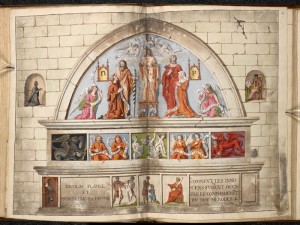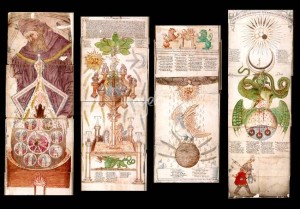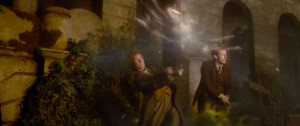Fantastic Alchemist: The 600-Year Legacy of Nicolas Flamel

Mar 22, 2018
Fantastic Beasts, Fantastic Beasts Movie, Harry Potter and the Philosophers / Sorcerers Stone, Jodorowsky, Leaky
It’s not uncommon to hear a Harry Potter fan say that the lessons learned from the story have made an impression on their actual lives. There are numerous organizations that have sprung from the values taught in those pages, and many of the words spoken by the beloved characters have found their way into our Muggle vernacular. Nicolas Flamel, the only character from the series that actually existed in real life, is another component traversing the divide between fact and fiction, and he may turn out to be a more significant part of the saga than we could have conjured up in Potions. On what marks 600 years to the day this legendary alchemist died, let’s take a closer look at the man, as well as the character, and his possible involvement in Crimes of Grindelwald.
Indeed, Nicolas Flamel not only occupies a hallowed place in history, but he is also quite the formidable and mysterious figure in the world of fantasy, popping up in great works of literature across the centuries. It’s no surprise, then, that the man who seemed to defy the laws of science and the physical world featured in J.K. Rowling’s magical series about Harry Potter and the Wizarding World.
In Harry Potter and the Philosopher’s Stone, we learned that Flamel was a close friend of Albus Dumbledore and partnered with the Headmaster to perfect his study of alchemy. He also created the mythic Philosopher’s Stone, from which he and his wife, Perenelle, derived the Elixir of Life, granting them both centuries beyond expectation. They enjoyed this long life until it came to light that the Dark Lord, Voldemort, intended to gain possession of the philosopher’s stone, using it to regain form and power. With such a threat upon them, Flamel agreed to destroy the stone so it might never fall into evil hands and be misused by them.
In real life, Flamel was a French scholar and bookseller who lived in 14th and early-15th century Paris. He may have dabbled in alchemy during his lifetime, but the legendary accounts of his reputation as an adept alchemist with knowledge of immortality didn’t surface until the 17th century. This excerpt from an essay on “Alchemy and Harry Potter” from the Leaky’s archives gives an in-depth look at Flamel’s life and why his death has become fodder for fantasy.
The Real Nicolas Flamel
Flamel was born in 1330 and died in 1418, along the way becoming one of the greatest alchemists in the world. The Bibliotheque Nationale in Paris contains works copied in his own hand and original works written by him. His wife, Perenelle, was a rare person indeed. She became his lifelong companion and confidante, keeping his secrets and assisting him in his studies to her dying day. She never revealed her husband’s secrets to anyone. Her secrecy caused no end of headaches for later researchers, because just what Flamel had discovered remains a mystery to this day.
What seems to be clear, however, is that Flamel owed his knowledge of alchemy and other esoterica to a single source: The Book of Abraham the Jew, which he received from a stranger who entered his bookstore one day. The book was full of Kabbalistic words in Greek and Hebrew, and Flamel had a devil of a time getting them translated.
Flamel made it his life’s work to understand the text of these lost secrets. He had acquired extensive knowledge of the alchemic arts prior to obtaining the book; by the 14th century, the wisdom of the Arabs and Jews had found their way to Christian Europe, and as a bookseller and copyist Flamel certainly had access to them. So he sought out the Arabs and Jews in order to decipher the book. He traveled to universities in Andalusia to consult with Jewish and Muslim authorities. In Spain, he met a mysterious master who taught him the art of understanding his manuscript, but it still took him 21 years to unravel the mystery of the book. Whether or not he succeeded in actually finding the Philosopher’s Stone is a matter still hotly debated.
In any case, after his return to France, Flamel suddenly became fabulously wealthy. He established low-income housing for the poor, founded hospitals and endowed churches, never living extravagantly himself. According to the historian Louis Figuier: “Husband and wife lavished succor on the poor, founded hospitals, built or repaired cemeteries, restored the front of Saint Genevieve des Ardents and endowed the institution of the Quinze-Vingts, the blind inmates of which, in memory of this fact, came every year to the church of Saint Jacques la Boucherie to pray for their benefactor, a practice which continued until 1789.”
On his death in 1418, Flamel was supposedly buried in a church and his tombstone decorated with the most amazing alchemical symbols imaginable. Some years later his grave was opened, and surprisingly enough the grave was empty. It was the same with Perenelle’s. A lot of sources allow for the possibility that maybe he really did find the Elixir of Life. Modern scientists have recreated his experiments in a modern laboratory and though it took 700 distillations they actually were able to reproduce part of his experiment.
What happened to The Book of Abraham the Jew after Flamel’s death? No one knows for sure, but somehow, Cardinal Richelieu (of The Three Musketeers fame) managed to acquire The Book of Abraham the Jew for his own collection. Richelieu’s personal library was, in fact, full of books on esoterica, the Occult and various Gnostic texts. How he managed to come by one of the most famous of all occult books is a mystery, but the book disappeared after his death, never to be seen again.
So did Flamel really die? Some think not, because of a curious figure that kept popping up throughout the eighteenth, nineteenth and early twentieth centuries in the person of the Comte de St. Germain. St. Germain was reported to be a French aristocrat who held the secrets of the Elixir of Life and who shared it with various French nobles and royals, including Madam Pompadour.
History knows quite a bit about St. Germain – except when he was born. The first we hear of him is in London and in 1745 in Edinburgh, where he was arrested for spying, presumably for the Jacobites that were waging war on the throne of England at the time. He disappeared in 1746 and was not seen again until 1758 in Versailles. During this time in Paris he gave diamonds as gifts and reputedly hinted that he was centuries old. In 1760 he left for England through Holland when the minister of State, the Duke of Choiseul, tried to have him arrested. After that the Count passed through the Netherlands into Russia and apparently was in St Petersburg when the Russian army put Catherine the Great on the throne. Later conspiracy theories credit him for causing it. Later he was in Belgium, offering his treatments of wood, oil and metals. While there, he hinted of a royal birth to the Belgian minister and actually turned iron into something resembling gold.
In 1763 he disappeared for 11 more years, and the next we hear of him is in Bavaria in 1774, then in Germany in 1776, where he once again offered his seemingly alchemic recipes. He alienated King Frederick’s emissaries by his claims of transmutation of gold and in some accounts compared himself to God and claimed to be a Freemason. He settled in a house of Prince Karl of Hesse-Kassel, governor of Schleswig-Holstein and studied herbal remedies and chemistry to give to the poor, claiming he was a Francis Rakoczy II, Prince of Transylvania.
According to Wikipedia, St. Germain died in 1784 of pneumonia. However, there were reported sightings of him alive in Paris in 1835 (by which time he would be at least 100 years old), Milan in 1867 and in Egypt during the Napoleonic Wars. Reports of him continue until 1926, which is, interestingly enough, the same year Tom Marvolo Riddle was born on December 31.
The idea of St. Germain and Flamel as one and the same person seems farfetched; however, one can’t help but wonder: where did St. Germain acquire the Elixir? Did he by chance stumble on the Book of Abraham the Jew, which disappeared after Cardinal Richelieu’s death? Or was it all a hoax? No matter the explanation, both Nicolas Flamel and the Comte de St. Germain remain two of the most intriguing characters in all of alchemy.
Though we may be unsure where Flamel the man ends and Flamel the character begins, the British Library’s Harry Potter a History of Magic Exhibition brought credibility to the alchemist’s story. Both Flamel’s tombstone, which was borrowed from the Musée de Cluny in Paris, and the Ripley Scroll, a six meter-long medieval manuscript said to be the recipe for the Philosopher’s Stone, were included in the display which attracted fans from all over the world for its four-month duration. A virtual version of the exhibition can now be found on Google Art and Culture and U.S. fans will be able to see the hands-on presentation when it opens at the New York Historical Society in October 2018.
Nicolas Flamel in Fantastic Beasts
Now it seems that his involvement in Harry’s story may not be the first time the fantastical Flamel was unwittingly caught up in a dark wizard’s treacherous rise to power. We now know he appears in the Fantastic Beasts series as well, portrayed by French-Mexican actor Brontis Jodorowsky. The new films cover the infamous campaign of Gellert Grindelwald to release the wizarding community from the bonds of secrecy and establish them as the superior ruling force in the world.
In order to do this, we have speculated he will exhaust all means necessary to achieve his ends—seeking out allies from ancient pureblood families, resuming his search for the three Hallows and harnessing other dark magical forces such as the obscurial power he witnessed in (we believe) Arianna Dumbledore and, later, Credence Barebone. He will leave no stone unturned. No stone.
Therefore, Grindelwald might, surely, also pursue the Philosopher’s Stone and the Elixir of Life it exudes. For if he possessed the Hallows and the stone, he would be virtually invincible, truly the Master of Death—magically imbued with long life and strength and more powerful than any foe who would oppose him.
So how might Nicolas Flamel feature in the next part of this thrilling story? He was conspicuously absent from the first official trailer for the upcoming Crimes of Grindelwald film. This leaves us wondering—does he play only a small role, so insignificant that it did not warrant taking up precious seconds of the all-too-brief trailer? Or does he figure prominently, in a pivotal way? This would be a plot point worthy of keeping under wraps, a secret from the analysts among us. Given that this film takes place in France, Flamel’s home country, we think the second far more likely!
What, then, are the possibilities?
As a former student of Beauxbatons Academy, Flamel might retreat to its protective halls in an effort to evade Grindelwald. We may even get a glimpse of the illustrious wizarding school if Dumbledore pays a visit to his old friend to advise caution.
Perhaps Dumbledore suggests that he keep his alchemical secrets under lock and key. Consider the mysterious image released last year. (See feature image.) Could it be a chest containing the stone? Maybe Dumbledore undertakes to place magical enchantments on the chest during his visit as a further protective measure. Or, if the stone is hidden away in some other location, perhaps it is a carefully-guarded and locked journal in which Flamel’s formulas are recorded. It would not be the first time a journal featured in the story, nor the first time a wizard gained unnatural ability via the instruction of superior intellect found in a book. If Grindelwald laid hands on the record of Flamel and Dumbledore’s work, he would not need the stone itself–he could create his own.
If this is as important as it seems, we may see Flamel guarded by a protective detail. We may also see the stone ferreted away for safe-keeping. It’s always possible the shot of Newt and Theseus Scamander in the graveyard has less to do with the Hallows and that legacy, as previously theorized, and more to do with securing the stone –either by fending off those who would steal it or by hiding it deep in the earth in a place of magical import.
Beyond the safe-guarding of the stone and objects related to it, Dumbledore might also consult with Flamel on Grindewald’s movements. Dumbledore is known to be a formidable wizard, not only gifted with incredible skill but also with a mastery of strategy, a chess master. Grindelwald, however, seems equally able to manipulate the pieces around him to best advantage. And, as noted in this interesting fan analysis, he may even go to time-traveling lengths to do it!
If this is the case, Flamel, with his broad experience, may have encountered Grindelwald across the centuries. With the benefit of this knowledge, Dumbledore could better piece together his former friends’ intentions—and better prioritize their next move against him.
However, it plays out, we look forward to seeing the legacy of Nicolas Flamel live on in the Fantastic Beasts series. Let us know your best Nicolas Flamel theories and catch Leaky’s essay on “Alchemy and Harry Potter” in its entirety here: Part 1 and Part 2












